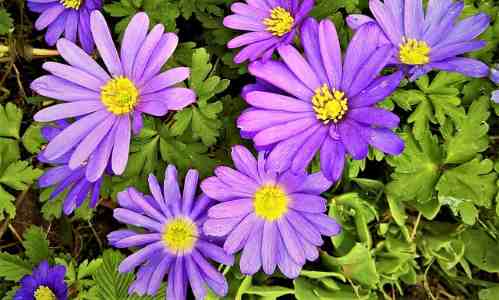55 Purple Perennial Flowers That Are Easy to Grow
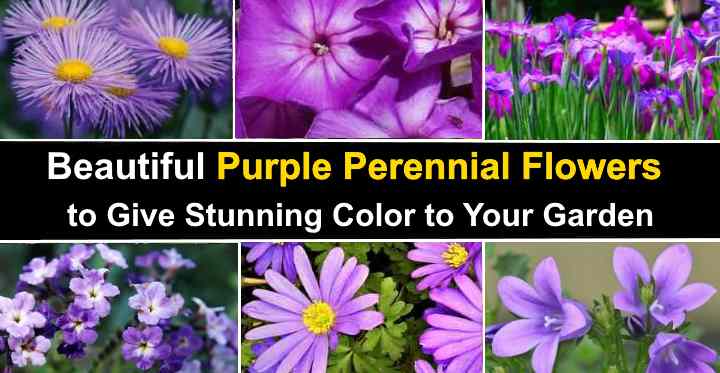
Flowering purple perennial plants add wonderful shades of lilac, violet, blue, and lavender to your garden. Purple perennial flowers vary in size from beautiful large blooms on a phlox to delicate violet petals on irises. Planting purple flowers is also a great way of attracting pollinating insects as the various purple shades attract bees and butterflies.
Some types of purple perennials are low-growing creeping plants that help to provide good ground cover. Other flowering perennials are larger shrubs or bushes that have stunning purple, mauve, and lilac clusters of flowers. Some tall perennials have purple flowers that grow at the end of long stems.
Purple, the color of royalty, adds a touch of class to your garden. Whatever your landscaping needs, there are purple perennial flowers to meet them.
In this article, you will find out about the qualities, features, and characteristics of the most popular purple flowering perennials.
What Are Perennial Plants?
Perennial plants are defined as plants that live more than two years, unlike annual plants that live one growing season, and then die. Flowering perennials grow and flower during spring and summer, die back during the cold season, and then grow back in spring.
Some flowering perennial plants are short-lived and last only a few years, whereas other perennials are long-lived.
Do Perennial Plants Come Back Year After Year?
Not all perennials come back year after year. Some perennial plants are not hardy and they don’t survive the harsh cold winter. They only grow one year and as such can be defined as annuals. They are also called tender perennials.
Some perennial plants can come back year after year. These are hardy perennials and they tolerate the harsh cold winter. They will keep coming back after a cold winter.
Some short lived perennial plants only bloom once in the second year and then die. In this case they will need to be replaced after 2-3 years. Other longer lived perennial plants lose their vibrant growth after several years and will need to be replaced from time to time.
Purple Perennial Flowers (With Pictures and Names)
Iris (Iris spp.)
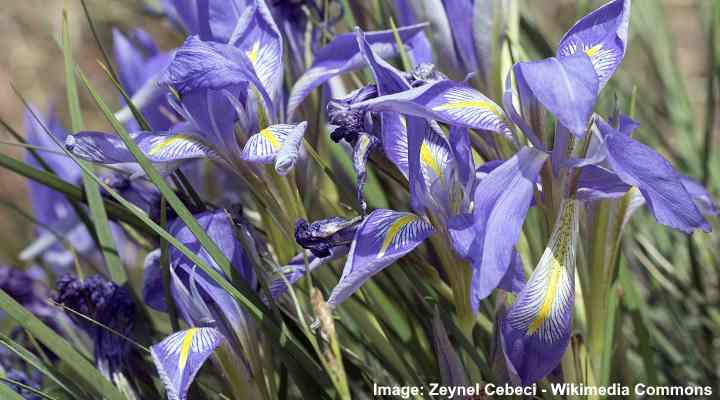
The iris is an extremely popular and common flower. There are many cultivars of iris with beautiful purple flowers
Iris is a bulbous perennial flowering plant that has some stunning purple cultivars. If you are looking for bright blue or purple flowering irises, then choose the ‘winter iris’ (Iris histrioides) or the ‘netted iris’ (Iris reticulata). However, other types of irises have been cultivated to flower in various shades of purple.
If you want to decorate your garden with incredibly beautiful purple flowers, then irises are one of the first bloomers in spring. Their delicate deep purple spring flowers appear near the end of January or start of February.
Purple flowering irises, as with other types of iris, are hardy perennial plants that survive winter. To make sure irises thrive, plant them where they get full sun at least a half day and in well-drained soil.
Irises are one of the best plants to bring color to mixed flower beds. Being relatively tall perennial flowers, it’s best to plant Iris flowers at the back of a flower bed, or you can plant them in a row as a border to define a landscaped area.
- USDA Hardiness Zone: Depends on the variety, generally 3-9
- Light: Full sun
- Soil: Well-drained
- Water Needs: Moderate
- Flowering Season: Late winter to early spring
Garden Phlox (Phlox paniculata)

Phlox paniculata ‘Blue Paradise’ (left) and phlox paniculata ‘Sternhimmel’ (right)
The Garden phlox (botanical name: Phlox paniculata) is a large bushy flowering perennial shrub that has some stunning purple varieties. Some phlox cultivars that have purple flowers that bloom in summer include ‘Grenadine Dream,’ ‘Violet Flame,’ ‘Peacock Neon Purple,’ and ‘Purple Eye Flame.’
Perennial phlox plants grow to about 4 ft. (1.2 m) tall and have a spread of around 3 ft. (0.9 m). From summer to the fall, large colorful flowers beautify this perennial with purple, white, pink, and red blossoms. To encourage more flowers to blossom, deadhead the plant after flowering in the fall.
Garden phlox are hardy flowering perennials in zones 4 to 8 and they love full sun. Plant garden phlox at the back of mixed flower beds, along walkways and borders.
- USDA Hardiness Zone: 4-8
- Light: Full sun
- Soil: Rich, well-drained
- Water Needs: Regular
- Flowering Season: Summer to fall
Clustered Bellflower (Campanula glomerata)
If you are looking for a perennial with purple summer flowers, then the clustered bellflower (Campanula glomerata) is a good choice.
This tall perennial flower grows to about 23” (58 cm) and has clusters of purple bell-shaped flowers. One stem can hold a number of dark purple flowers measuring about 1” (3 cm). The clustered bellflower thrives in full sun and can also withstand partial shade.
There are also other types of bellflowers that produce purple flowers in the summer. Some cultivars include rampion bellflower (Campanula rapunculus) with its star-shaped light mauve flowers or the harebell (Campanula rotundifolia) with lilac or lavender colored bell flowers.
Clustered bellflowers are cold hardy perennial plants that require full sun, and can be planted in rock garden or at the back of a perennial border or flower bed.
- USDA Hardiness Zone: 4-8
- Light: Full sun to partial shade
- Soil: Well-drained, fertile
- Water Needs: Moderate
- Flowering Season: Summer
Milky Bellflower (Campanula lactiflora)
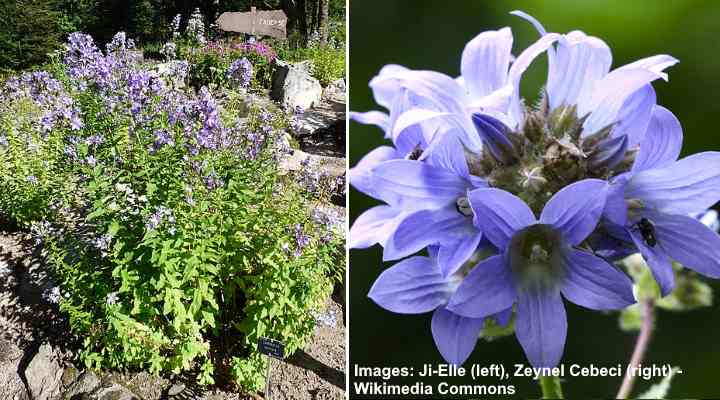
Milky Bellflower (Campanula lactiflora)
Milky bellflower is a tall perennial plant with stunning purple bell-shaped flowers in summer. The perennial produces masses of attractive flowers with five flared petals in deep lavender colors. Additionally, lance-shaped, toothed leaves create clumping foliage, giving the plant an attractive, upright, open shape.
Milky bellflower grows 3 to 5 ft. (1 – 1.5 m) tall and 3 ft. (1 m) wide. Its mound of purple flowers and foliage is perfect for adding height, texture, and color to flower beds and borders. It also attracts bees and butterflies, making it a great addition to pollinator gardens.
- USDA Hardiness Zone: 5-8
- Light: Full sun to partial shade
- Soil: Well-drained, chalky, or loamy soils that drain well
- Water Needs: Regular watering to prevent the soil from during out
- Flowering Season: Summer to early fall
Geranium (Geranium spp.)
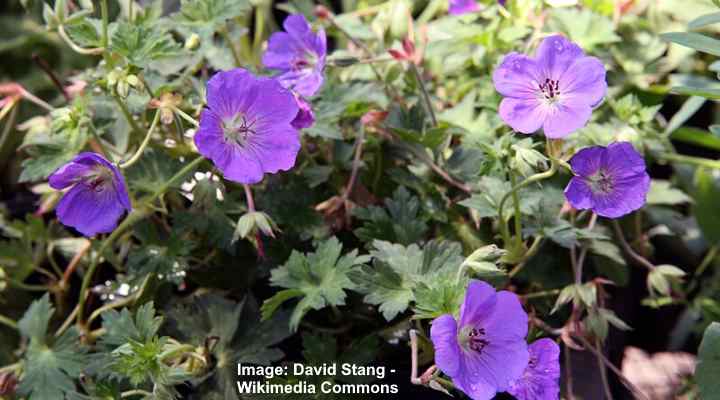
‘Rozanne’ geranium is hardy purple perennial best grown in full sun
Geranium is extremely common perennial flower. Some geranium varieties have purple flowers that blossom in spring and last throughout the summer. Two types of flowering purple perennials are the ‘Rozanne’ geranium and the ‘Johnson’s Blue’ geranium. Both of these geranium cultivars have deep blue/purple delicate petals.
Apart from having purple summer blossoms, other types of geraniums produce white, pink, and blue flowers. Planting winter-hardy geranium perennials is a good landscaping option as they have attractive foliage and small colorful flowers. Some geranium cultivars grow as high as 2 ft. (60 cm) and have a spread of the same size.
To fill your garden with spring and summer purple flowers, plant geraniums in sunny areas of your garden. They are popular bedding plants in the garden and can be also used as a ground-cover.
- USDA Hardiness Zone: 4-8
- Light: Full sun
- Soil: Well-drained
- Water Needs: Average
- Flowering Season: Spring to summer
Salvia (Sage)
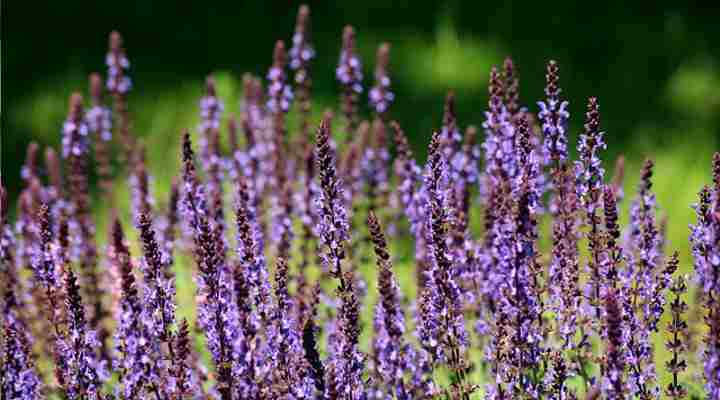
Sage is purple perennial herb that grows well in hot sunny climate
Salvia is an herbaceous purple flowering plant that grows every year and produces showy small flowers all summer long.
This easy care purple perennial herb loves to grow in hot sunny climates. The flowering stems grow upright and consist of needle-like leaves with small blossoms on them. Although purple is a common type of salvia, some varieties also produce blue, red, or white flowers.
Apart from producing attractive purple flowers every year, many grow salvia (Salvia officinalis) for its delicious taste. Sage (salvia) is a popular herb used in Mediterranean, British, and American cooking. You can also use sage for its medicinal properties.
Salvia plants include various types ranging in height from 18” (45 cm) to 5 ft. (1.5 m). Tall varieties can be grown at the back of flower beds and borders, and they can grow in containers too.
- USDA Hardiness Zone: Varies, commonly 5-9
- Light: Full sun
- Soil: Well-drained, average
- Water Needs: Low to moderate
- Flowering Season: Summer
Meadow Sage (Salvia nemorosa)
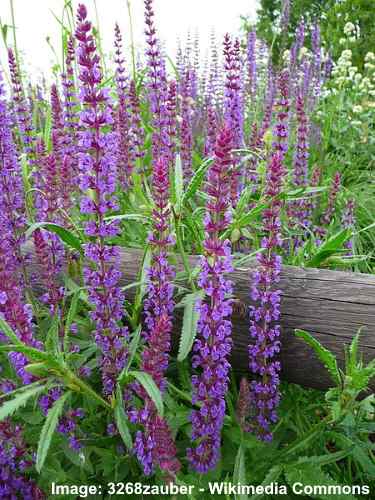
Meadow Sage (Salvia nemorosa)
Also called woodland sage, this beautiful purple perennial blooms in summer and fall with 3 ft. (1 m) tall violet-purple flowering spikes. This compact sage plant is low-maintenance, drought-tolerant, and suitable for growing in colder climates. Its purple flowers attract pollinators such as bees and butterflies. It is also rabbit and deer-resistant.
- USDA Hardiness Zone: 4-8
- Light: Full sun or partial shade
- Soil: Well-drained sandy or rocky soil that has high organic matter
- Water Needs: Low to moderate
- Flowering Season: Summer and fall
Veronica (Veronica spicata)
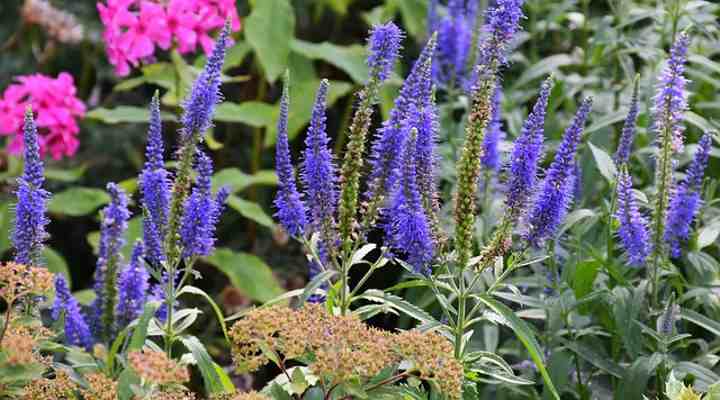
Veronica is a tall perennial with purple flowers at the end of each stem
Veronica, also known as speedwell, is a perennial plant with stunning, bushy purple flowers. Purple Veronica cultivars feature tall stems adorned with long purple flowers at the ends. Depending on the plant type, the blossoms can resemble dark purple spikes or large clusters of tiny purple flowers. Notable varieties of purple flowering speedwell include ‘Royal Candles’ and Veronica ‘Purple Explosion.’
This low-maintenance perennial blooms year after year and is hardy down to USDA zone 3. To fully appreciate the stunning purple blooms, plant this perennial in full sun behind other smaller bedding plants.
- USDA Hardiness Zone: 3-8
- Light: Full sun
- Soil: Well-drained, fertile
- Water Needs: Average
- Flowering Season: Late spring to summer
Anemone (Anemone spp.)
Anemone is a group of plants that include perennial varieties which produce purple spring flowers.
The most common variety of purple anemone is the ‘Winter Windflower’ (Anemone blanda) with purple-blue petals and a striking yellow center. It grows in zone 5 – 8 in full sun to part shade. Other purple spring flowering varieties include the broad-leaved anemone (Anemone hortensis) with light violet star-shaped flowers.
To make sure this purple perennial blooms in the early spring, plant Anemone in full sun to partial shady areas of your garden. Plant in rich, moist soil in the front of a flower bed or a border.
- USDA Hardiness Zone: 5-8
- Light: Full sun to partial shade
- Soil: Moist, well-drained
- Water Needs: Regular
- Flowering Season: Early spring
Aster (Aster spp.)
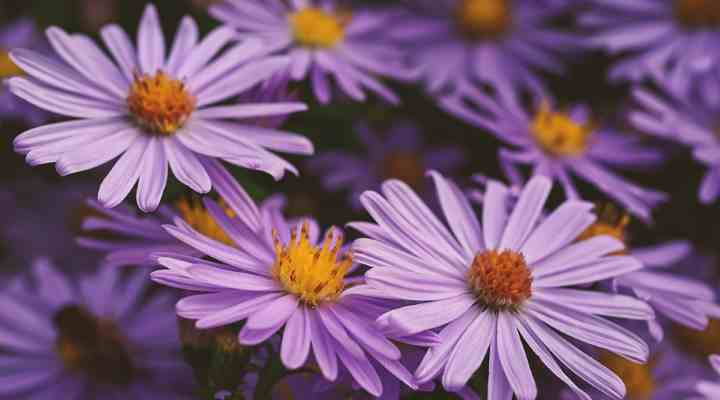
Asters are perennial flowering plants with attractive purple flowers
There are a number of tall purple perennials to choose from, but aster plants seem to be a favorite for sunny gardens.
The purple color of aster flowers is highly attractive to bees, butterflies and other pollinators. The purple or lilac daisy-shaped flowers sit on the top of long stems that can grow up to 8 ft. (2.4 m) high. However, most varieties of this perennial are shorter.
The light purple petals are also quite attractive. Some aster cultivars have multilayered dark purple petals giving the flower head a puffy look.
If you have asters in your garden, you can expect purple blossoms to appear in late summer or the fall. This means that asters are one of the latest of the purple flowering plants to bloom.
Most asters varieties grow well in full sun while some varieties tolerate partial shade. Depending on the variety, their USDA hardiness zones are 4 to 8. Plant tall asters at the back of flower beds and borders.
- USDA Hardiness Zone: 4-8
- Light: Full sun to partial shade
- Soil: Well-drained, average
- Water Needs: Average
- Flowering Season: Late summer to fall
Chrysanthemum (Chrysanthemum spp.)
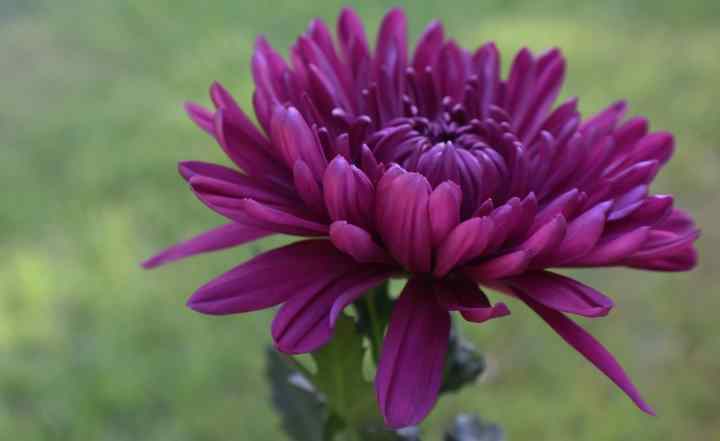
Chrysanthemums have several cultivars with purple flowers
Chrysanthemum is another type of purple perennial that blooms late in the summer. These plants produce bursts of purples, lilacs, and mauves when they flower in July and August.
Chrysanthemums are a flowering plant that come in many colors. Some types of “mums” with purple flowers include ‘Lynn’ which has two-tone lavender colors and a purple center, ‘Stargazer’ with dark lavender petals, and ‘Barbara’ with blooms that look like purple pompons.
Depending on the type of chrysanthemum, they grow between 1.5 and 3 ft. (45 – 90 cm) tall and have a spread of around 3 ft. (90 cm).
One reason why chrysanthemum perennials are so popular is for the sheer number of flowers from each plant. If you plant a number of varieties, you will have delightful purples, reds, yellows, and whites brightening your garden.
Chrysanthemums thrive in full sun and are suitable for growing in USDA hardiness zones 5-9. Grow them in mixed flower beds, borders, or as a stand-alone specimen.
- USDA Hardiness Zone: 5-9
- Light: Full sun
- Soil: Well-drained, fertile
- Water Needs: Regular
- Flowering Season: Summer
Blue False Indigo (Baptisia australis)
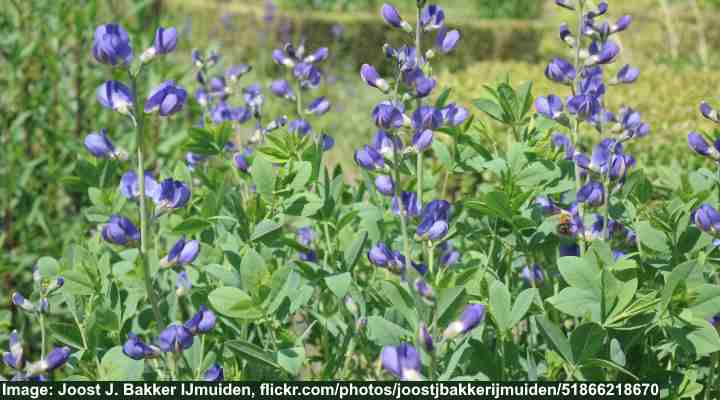
The blue false indigo is a perennial bush with purple flowers
The Blue Indigo (Baptisia australis) is a delightful bushy perennial with small purple flowers and is on the list of early spring bloomers.
This shrub-like plant has long stems that can grow up to 5 ft. (1.5 m) tall and spread between 2 ft. and 3 ft. (0.6 – 1 m). The stems contain small ovate leaves that provide good ground cover with dense foliage.
In early spring and summer when Blue False Indigo blossoms, small pea-sized dark purple or blue flowers appear on long stems. These purple flowering stems can increase the height of the False Indigo by 1 to 2 ft. (30 – 60 cm).
You can plant these purple perennials where they get sun all day and in well-drained soil. USDA hardiness zones are 3 to 10.
- USDA Hardiness Zone: 3-10
- Light: Full sun
- Soil: Well-drained
- Water Needs: Moderate
- Flowering Season: Early spring to summer
Clematis ‘Etoile Violette’

Clematis ‘Etoile Violette’ is a climber shrub with dark purple flowers
The Clematis cultivar ‘Etoile Violette’ is a great landscaping option if you are looking for a perennial climbing plant that has deep purple or violet flowers.
The Etoile Violette has broad dark-violet-purple petals that can be as large as 4” (10 cm) across. These showy purple flowers bloom mid to late-summer and can add a lot of color to a trellis, arbor, wall or fence. The purple climber shrub thrives in full sun or part shade and needs to have moist, well-drained soil.
One of the reasons to add this purple flowering vine is that it grows very quickly every year. The purple clematis plant produces an abundance of purple flowers and can grow between 10 and 15 ft. (3 – 4 m) long.
Clematis are hardy perennials in zones 4-9.
- USDA Hardiness Zone: 4-9
- Light: Full sun to part shade
- Soil: Moist, well-drained
- Water Needs: Moderate
- Flowering Season: Mid to late summer
Jackman’s Clematis (Clematis ‘Jackmanii’)
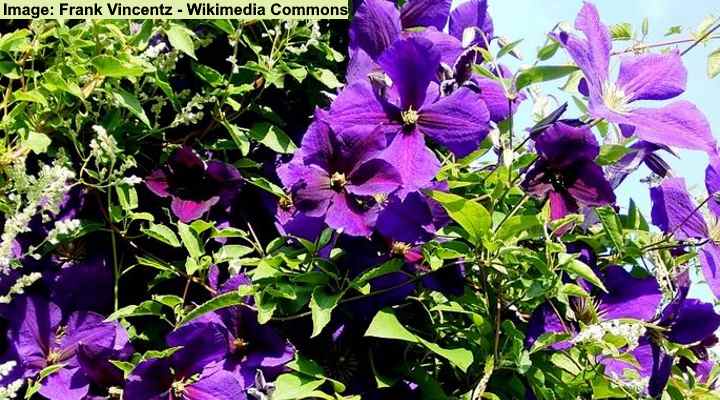
Clematis ‘Jackmanii’
Jackman’s clematis is a purple-flowering perennial vine that blooms in summer with velvety dark purple flowers. The four-petalled blossoms grow 4” (10 cm) in diameter and contrast nicely with mid-green foliage consisting of arrowhead-shaped leaves. The vigorous grower is ideal for climbing walls, arbors, fences, or trellises.
Free-flowering Jackman’s clematis grows 8 to 12 ft. (2.4 – 3.6 m) tall and spreads up to 6 ft. (1.8 m) wide.
- USDA Hardiness Zone: 4-11
- Light: Full sun to partial shade
- Soil: Well-drained, moist soils
- Water Needs: Regular watering to keep the ground moist in summer
- Flowering Season: Throughout summer
Garden Heliotrope (Heliotropium arborescens)
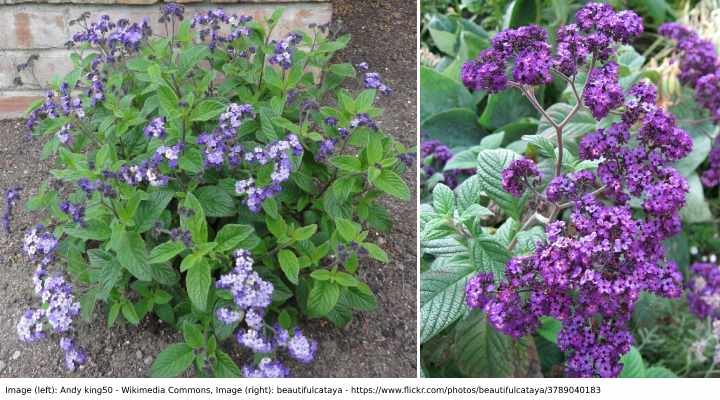
Garden heliotropes are perennial bushes with purple flowers in clusters
This tall purple perennial flowering shrub produces clusters of bright tiny purple flowers. One of the interesting features of these clustered violet-purple flowers is their delicate vanilla fragrance.
These evergreen shrubs grow up to 3.9 ft. (1.2 m) tall, although you can get smaller varieties for growing in containers. The blooming shrub has large leaves that provide good ground cover with purple flowers. This flowering perennial shrub grows well as a border or feature in a flower bed.
The delightful purple summer flower clusters can grow up to 4” (10 cm) across. Some cultivars have larger purple flowerheads. For example, the ‘Marine’ has large purple clusters measuring 6” (15 cm) in diameter.
This bushy perennial shouldn’t be confused with the herb valerian, which is also referred to as “garden heliotrope.”
Heliotrope is a tender perennial (hardy in USDA zones 10 and 11) and in colder areas it is grown as an annual.
- USDA Hardiness Zone: 10-11
- Light: Full sun to partial shade
- Soil: Well-drained
- Water Needs: Moderate
- Flowering Season: Summer
Crocus
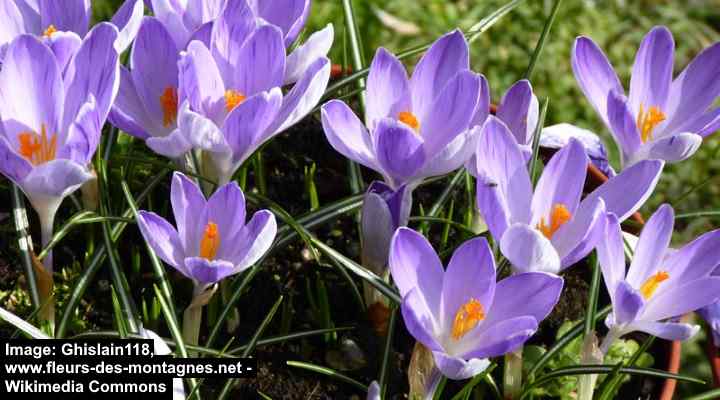
The crocus is a purple perennial bulbous plant
Crocus is one of the plants that produce purple flowers in the early spring. Crocuses are a type of flower that grows from bulbs and the purple and lavender colored cultivars are very popular.
There are around 90 species of this perennial bulbous plant. Some types of crocuses are cultivated to flower in the fall, winter, or spring. If you plant many crocus bulbs together, your garden can be transformed into an array of many different colors.
Some crocus cultivars have multicolored petals. For example, ‘Bieberstein’s crocus’ (Crocus speciosus) has large light lilac petals that fade to almost white and has dark purple veins running through it. Other crocuses with purple flowers are the ‘Tuscan crocus’ (Crocus etruscus), Crocus banaticus with its light purple flowers and purple stamens, and the light purple ‘Crocus corsicus.’
Being a low perennial plant that grows only 4 to 5 inches tall (10-12 cm), plant it at the front of flower beds and borders in full sun or partial shade.
- USDA Hardiness Zone: 3 to 8.
- Light: Crocuses prefer full sun but can tolerate partial shade.
- Soil: Well-drained and rich soil is ideal for growing crocuses.
- Water Needs: Crocuses generally require moderate watering, allowing the soil to dry out slightly between waterings.
- Flowering Season: Crocuses typically bloom in early spring, adding vibrant colors to gardens during the season.
Delphinium
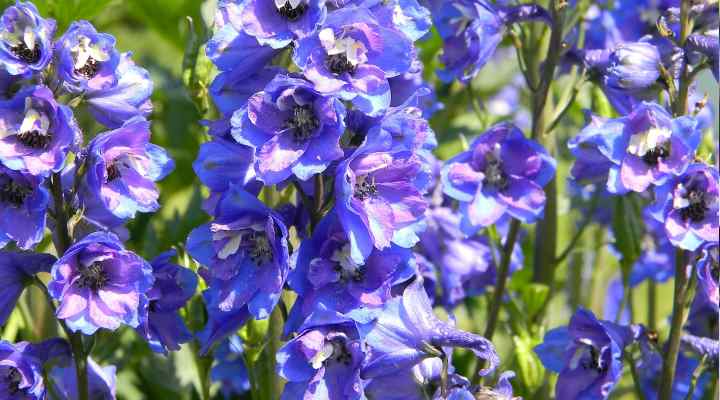
Delphiniums have long stems with purple flowers
One stunning type of sun-loving purple perennial is the delphinium with its long cone-shaped purple and lilac blooms.
There are actually many varieties of flowering plants in the delphinium genus. Delphiniums are tall flowering perennial plants with purple flowers, and they can grow up to 6.5 ft. (2 m) tall! It can be challenging to grow delphiniums in your garden. The tall perennials need full sun but not hot dry summer. They are also susceptible to breaking if there is a strong wind.
Some of the best flowering purple delphiniums are in the ‘Belladonna’ group and ‘Elatum’ group. If you want to adorn your garden with stunning purple blooms, look for ‘Blue Bees,’ ‘Bruce,’ and ‘Blue Nile’ varieties of delphiniums.
Delphiniums will generally grow well in zones 3-8.
- USDA Hardiness Zone: 3 to 8
- Light: Full sun, partial shade in hotter climates
- Soil: Well-drained, fertile soil with good organic content
- Water Needs: Regular watering to keep the soil consistently moist
- Flowering Season: Early to mid-summer
Lavender (Lavandula spp.)

A field of lavender
Lavender is one of the most well-known types of purple perennial flowering herbs. This drought tolerant plant has purple flowers with fragrant aromas that are a delight in any garden.
Although there are many lavender cultivars, they all have one thing in common. This common flowering herb produces various shades of purple flowers every year. Some cultivars have darker purple flowers, some have the traditional lavender color, and other gorgeous flowers have an almost blackish purple hue.
The purple flowering shoots from lavender plants can grow between 8” and 16” (20 – 40 cm) long. Because the flowering spikes are longer than their leaves, fields of lavender can look like a sea of purple when in full bloom.
Plant lavender flowers in a location that gets full sunshine all day long and in moist, well-drained soil. Place lavender plants at the middle or back position of borders and beds.
Lavender is also famed for its healing essential oil that treats wounds and helps you get to sleep better.
Hardiness Zones: 5 to 9
- USDA Hardiness Zone: 5 to 9
- Light: Full sunshine
- Soil: Moist, well-drained soil
- Water Needs: Drought tolerant once established
- Flowering Season: Summer
Millennium Flowering Allium (Allium ‘Millenium’)
Ornamental onions such as the ‘Millenium Flowering Onion,’ ‘Round and Purple,’ or ‘Purple Sensation’ produce fuzzy purple flowers that bloom into large ball-shaped clusters.
Purple flowering onions make a great addition to any garden and add a splash of color and also attract pollinators. Flowering onions are especially good for their purple colorful hues as their blooms last a long time. They are also hardy perennials that can withstand temperatures as low as -20°F (-6°C).
Plant Ornamental onions in the garden in an area that gets sun all day. These tall perennial plants can reach 4 ft. (1.2 m) high and will give a vertical focal point at the back of flower beds and borders.
- USDA Hardiness Zone: 4 to 10
- Light: Full sun
- Soil: Well-drained soil
- Water Needs: Moderate watering needs
- Flowering Season: Late spring to early summer
Blazing Star (Liatris spicata)
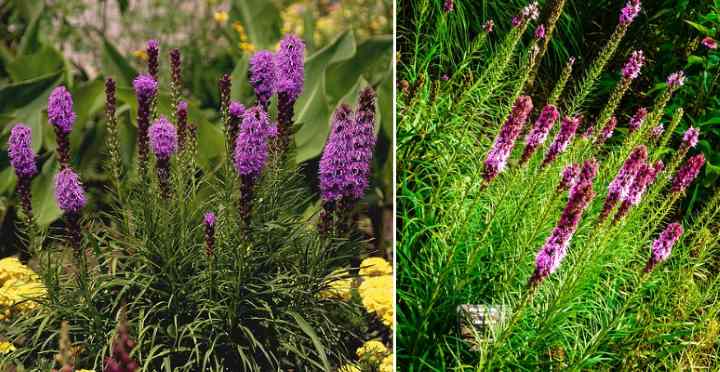
Blazing star flowers can be purple, pink or white
Blazing star is a tall, elegant perennial with stunning purple flower spikes. Blooming from mid to late summer, the purple bottlebrush flowers look stunning at the top of stems, which are 3 to 5 ft. (1 – 1.5 m) tall. The vibrant purple flowers attract bees, butterflies, and hummingbirds, enhancing your garden’s biodiversity.
Also called gayfeather, the blazing star forms clumps of deep green, grassy foliage. This resilient purple perennial adds texture and color to garden landscapes. The plant thrives in full sun and tolerates sandy, gravely dry soil that drains well. It’s an ideal addition to perennial borders, native plant gardens, and rock gardens.
Other varieties of purple-flowering blazing star perennials include:
- Texas Blazing Star (Liatris punctata var. mucronata): Native to Texas, the purple flowering plant grows up to 3 ft. (1 m) tall and creates a strong vertical accent in sunny perennial borders.
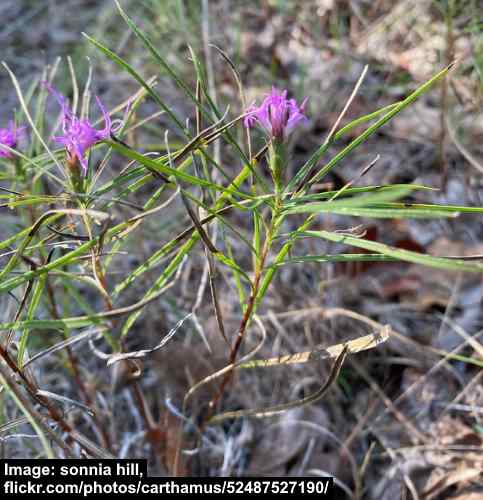
Texas Blazing Star (Liatris punctata var. mucronata)
- Dwarf Blazing Star (Liatris cylindracea): This low-growing perennial has purple thistle-like flowers on stems 2 ft. (0.6 m) tall.
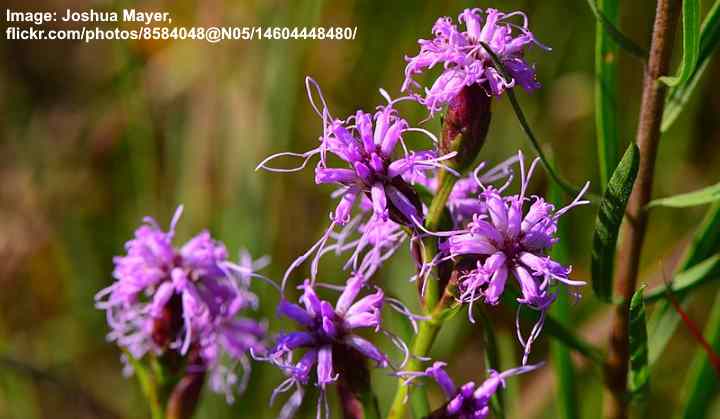
Dwarf Blazing Star (Liatris cylindracea)
- Rocky Mountain Blazing Star (Liatris ligulistylis): This upright perennial has purple flowering spikes growing among clumps of grass-like foliage. It grows 3 ft. (1 m) tall and 2 ft. (0.6 m) wide.
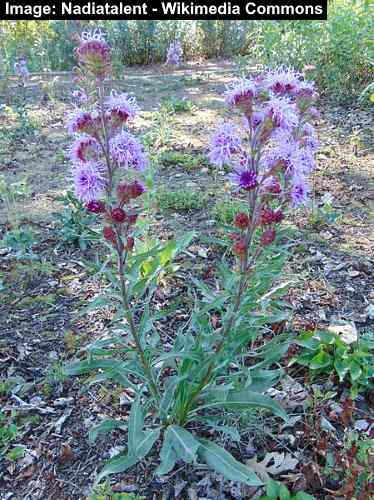
Rocky Mountain Blazing Star (Liatris ligulistylis)
Thanks to its colorful, fragrant, and nectar-rich flowers, blazing star is a great addition to wildlife gardens for attracting hummingbirds, bees, and butterflies.
- USDA Hardiness Zone: 3-9
- Light: Full sun
- Soil: Well-drained
- Water Needs: Low to moderate
- Flowering Season: Mid to late summer and through fall
Lily of the Nile (Agapanthus)
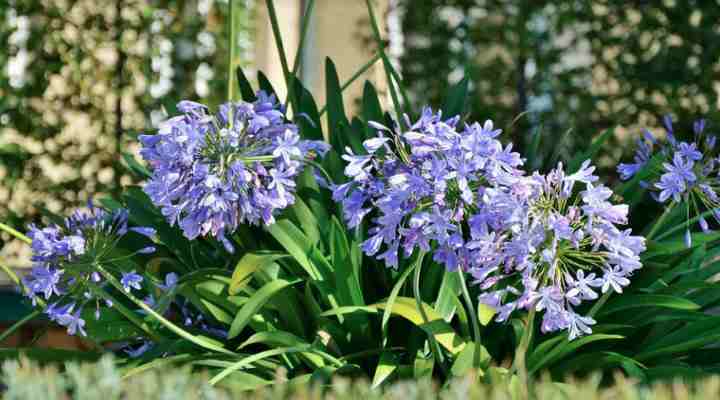
Lily of the Nile (Agapanthus) flowers
Lily of the Nile is an exotic, purple-flowering perennial that blooms throughout the summer. This plant is characterized by its spherical clusters of tubular purple flowers. Each flowerhead can have 20 to 100 rich blue to purple flowers. Also called African lily, the perennial grows 1 to 4 ft. (0.3 – 1.2 m) tall and wide.
Lily of the Nile is a drought-tolerant plant that can withstand dry conditions. Its long blooming season extends from summer to early fall. The eye-catching flowers create a striking appearance in perennial borders, containers, wildlife gardens, and coastal landscapes.
Lily of the Nile purple flowers and strappy leaves are deer and rabbit-resistant.
- USDA Hardiness Zone: 7-11
- Light: Full sun to partial shade
- Soil: Well-drained
- Water Needs: Regular, but tolerates dry conditions
- Flowering Season: Mid-summer to late fall if you deadhead them to promote extended blooming
Purple Loosestrife (Lythrum salicaria)
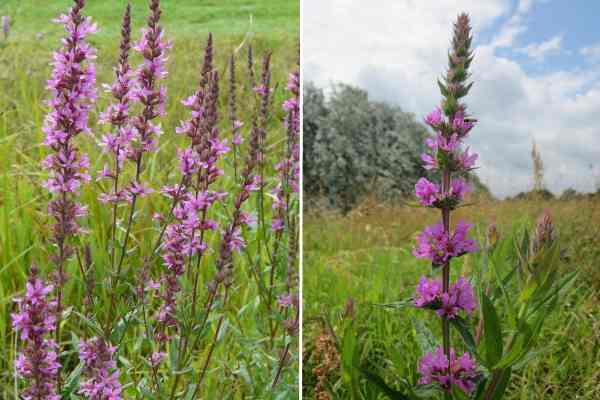
Purple loosestrife flower spikes
Purple loosestrife is a tall perennial plant that blooms throughout summer with tall spikes of vibrant purple or magenta flowers. The purple perennial grows 2 to 4 ft. (0.6 – 1.2 m) tall and thrives in wet, boggy soils. Therefore, it is popular for growing in wetland gardens or near backyard ponds.
Purple loosestrife nectar-rich flowers attract butterflies and bees, making it a great addition to pollinator gardens. Thriving in full sun or partial shade, the vigorous perennial spreads quickly in moist soils. Unfortunately, it has invasive tendencies, requiring careful control to stop it from spreading.
- USDA Hardiness Zone: 4-9
- Light: Full sun to partial shade
- Soil: Moist, well-drained soils but tolerate soggy soil
- Water Needs: Average to high
- Flowering Season: Summer to early fall
Purple Dutch Hyacinth (Hyacinthus orientalis)
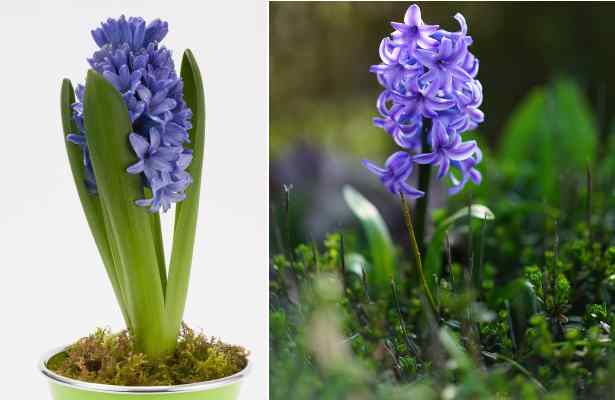
Purple Dutch hyacinth flowers
The purple Dutch hyacinth is a popular spring-blooming bulbous perennial with dense clusters of fragrant, tubular purple flowers. The amethyst, rich purple flowers have an intense color and sweet scent. These contrast with the elongated bright green leaves as they bloom for three weeks in mid-spring.
Purple Dutch hyacinths require average watering and full sun for the best blooms. You can plant the purple-flowering bulbs in moderately fertile soil. They perform best in window boxes, beds, borders, and underplanting shrubs or trees. The common hyacinths grow well in containers, adding vibrant colors and fragrance to a patio or decking area.
- USDA Hardiness Zone: 4-8
- Light: Full sun to partial shade
- Soil: Well-drained, moderately fertile soils
- Water Needs: Moderate without the ground becoming waterlogged
- Flowering Season: Mid-spring
Rock Cress (Aubrieta deltoidea)
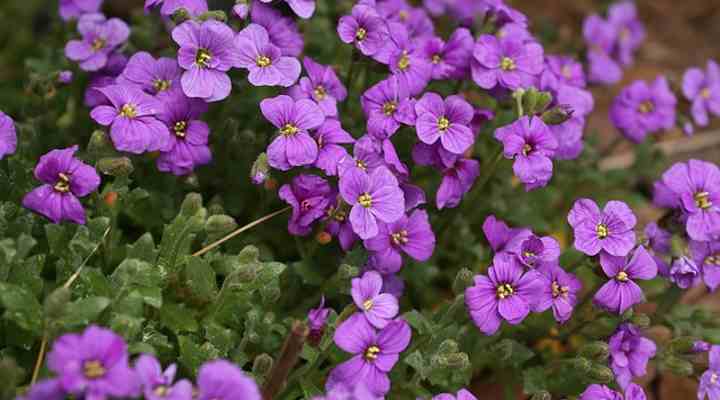
Rock cress flowers
Rock cress is a ground-hugging perennial plant that creates a carpet of beautiful purple flowers. The semi-evergreen ground cover plant blooms in spring and summer with vibrant flowers contrasting with gray-green foliage. The mat-forming plant grows 9” (23 cm) tall and is ideal for growing along pathways or in rock gardens.
The purple flowers of rock cress create stunning, colorful displays in early spring and summer. Once established, the hardy perennial tolerates drought, salt spray, and full sun. Therefore, it’s a perfect landscaping solution for coastal gardens, slopes, borders, ground cover, and garden edging. It is also deer-resistant.
Deadheading rock cress flowers encourages more flowering. This way, you can entice pollinators like bees and butterflies to your spring and summer landscapes.
- USDA Hardiness Zone: 5-7
- Light: Full sun to partial shade
- Soil: Well-drained but can tolerate drought and salty soils
- Water Needs: Low to moderate
- Flowering Season: Mid-spring through early summer
African Daisy (Osteospermum)
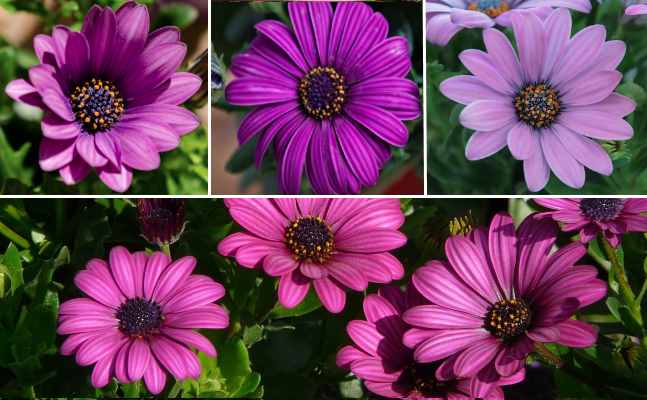
African daisy flowers are perennials in warm zones
The African daisy is a tropical tender perennial with lavender-purple daisy-like flowers and dark centers. The vibrant purple flowers bloom from early spring until frost. The bushy plant has lance-shaped green leaves and a mounding habit up to 1 ft. (0.3 m) tall. The purple perennial performs best in cool summers but doesn’t withstand cold winters.
African daisies typically grow as annuals in growing zones below 10. You can grow the bushy purple-flowering plants in rock gardens, beds, or coastal gardens. They are also rabbit and deer-resistant and tolerate drought and neglect.
- USDA Hardiness Zone: 10 and 11
- Light: Full sun
- Soil: Well-drained, moderately fertile soils
- Water Needs: Low to moderate once established
- Flowering Season: Late spring to fall
Silver Lupine (Lupinus albifrons)

Silver lupine flower spikes
Silver lupine is a stunning perennial with masses of pea-like purple flowers growing on tall spikes. Blooming from early spring, the fast-growing shrubby plant has clumps of silver-gray palmate leaves around the tall flowering stems. Silver lupine grows 3 to 5 ft. (1 – 1.5 m) tall and wide.
Silver lupine is a drought-tolerant purple plant native to California. It performs well in dry, well-drained soils, making it perfect for desert landscapes. Its ornamental features and tall flowers are ideal for planting at the back of a bed to add height, color, and texture.
- USDA Hardiness Zone: 6-10
- Light: Full sun
- Soil: Well-drained, rocky, sandy, dry soils
- Water Needs: Low requirements, only needing watering once or twice a month
- Flowering Season: Early spring to early summer
Anise Hyssop (Agastache foeniculum)
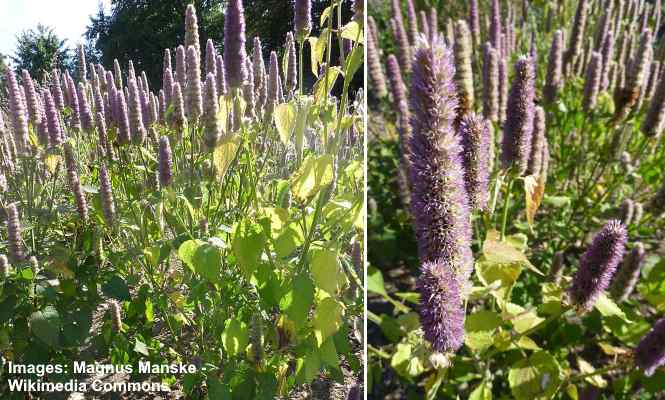
Agastache foeniculum
Anise hyssop is a beautiful clump-forming perennial plant with attractive spikes of purple or lavender flowers. Blooming in summer and fall, the slender conical purple clusters create vertical lines in landscapes. The aromatic foliage of serrated, triangular leaves smell like licorice when crushed. The attractive flowers also look nice in dried floral arrangements.
Also called lavender hyssop, anise hyssop is a hardy plant with excellent tolerance to cold winters. The clumping perennial also tolerates drought, deer, and pests. You can plant anise hyssop to make a dramatic impact in butterfly gardens, beds, borders, or cottage gardens. It thrives in well-drained soil and does not require much water once established.
- USDA Hardiness Zone: 4-8
- Light: Full sun to partial shade
- Soil: Well-drained, dry to medium moisture soils
- Water Needs: Low to moderate
- Flowering Season: Early summer to the fall
Eggleaf Beardtongue (Penstemon ovatus)
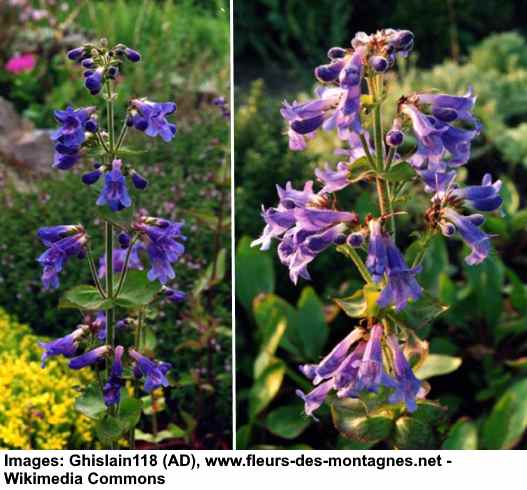
Eggleaf beardtongue flowers
Eggleaf beardtongue is a beautiful perennial with vibrant purple tubular flowers blooming from late spring through fall. Native to North America, the striking perennial grows 1 to 3 ft. (0.3 – 1 m) tall and 2 ft. (0.6 m) wide. It’s easy to grow in most landscapes.
Eggleaf beardtongue’s clusters of tubular purple flowers add a touch of colors to landscapes. The small flowers attract hummingbirds and pollinators such as bees and butterflies. Despite its vigorous growth, it doesn’t become invasive but naturalizes easily in native landscapes.
- USDA Hardiness Zone: 4-8
- Light: Full sun to part shade
- Soil: Fertile, well-drained
- Water Needs: Low to moderate and allow the ground to dry out between waterings
- Flowering Season: Late spring to early fall
Purple-Flowering Bee Balm (Monarda)
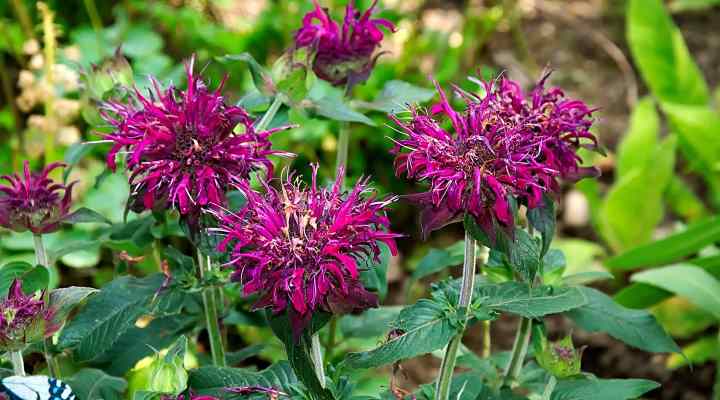
Purple-flowering bee balm flowers
Purple-flowering bee balm perennials bloom in late spring with clusters of vibrant, deep purple flowers on erect stems. The thistle-like flowers have clusters of wiry purple petals on whorls of decorative bracts. The vibrant purple shades contrast with the aromatic green leaves. The clumps of leafy upright flowering stems grow up to 3 ft. (1 m) tall.
The purple flowers of perennial bee balm plants add color and texture to sunny summer gardens. The hardy perennials perform well in informal borders, massed for ground cover or planting as an accent plant. The colorful purple flowers attract pollinators, and its foliage is rabbit and deer-resistant.
- USDA Hardiness Zone: 4-9
- Light: Full sun to partial shade
- Soil: Moist, humus-rich, fertile soils that drain well
- Water Needs: Regular watering to keep the soil moist in summer
- Flowering Season: Summer
Pincushion Flower (Scabiosa columbaria)
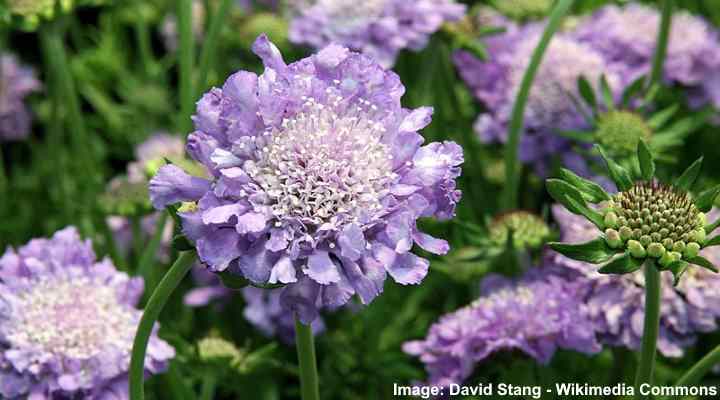
Scabiosa columbaria ‘Butterfly Blue’
Pincushion flower is a beautiful purple-flowering perennial that grows in clumps. The spring-blooming plant has mounds of fern-like fuzzy foliage and masses of pincushion-like pale purple and whitish flowers. The attractive ruffled flowers measure 3” (7.5 cm) across and attract butterflies to coastal and city gardens.
The unique violet-blue flowers of the pincushion plant sit atop wiry stems. The ferny foliage and showy flowers are a great addition to beds and borders, cottage gardens, and container planting. This low-growing perennial plant requires constant moisture and regular watering to bloom all season.
- USDA Hardiness Zone: 4-10
- Light: Full sun to partial shade
- Soil: Well-drained, consistently moist soil in southern gardens
- Water Needs: Regular
- Flowering Season: Late spring to early fall
Jerusalem Sage (Phlomis tuberosa)
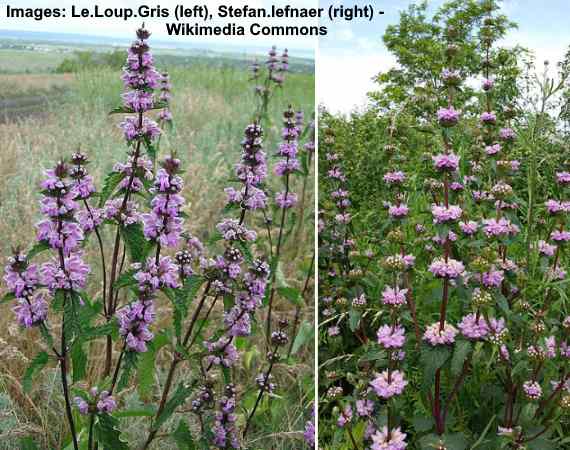
Jerusalem sage flowers
Jerusalem sage is a unique perennial plant with clusters of lavender-pink flowers growing in whorls on red stems. The attractive plant also grows mounds of low-growing foliage consisting of arrowhead-shaped leaves. However, its ornamental feature is how purple flower clusters rise from the basal foliage 3 to 5 ft. (1 – m) tall.
Jerusalem sage blooms from late spring through winter. The sun-loving perennials perform well in hot, dry conditions and tolerate drought and light shade. You can grow the purple flowers and evergreen foliage to add color and texture to beds, borders, ground cover, and garden edging.
- USDA Hardiness Zone: 6-9
- Light: Full sun or light shade
- Soil: Well-drained, fertile, or sandy soils with medium moisture
- Water Needs: Low once established
- Flowering Season: Late spring through winter
Joe-Pye Weed (Eupatorium purpureum)
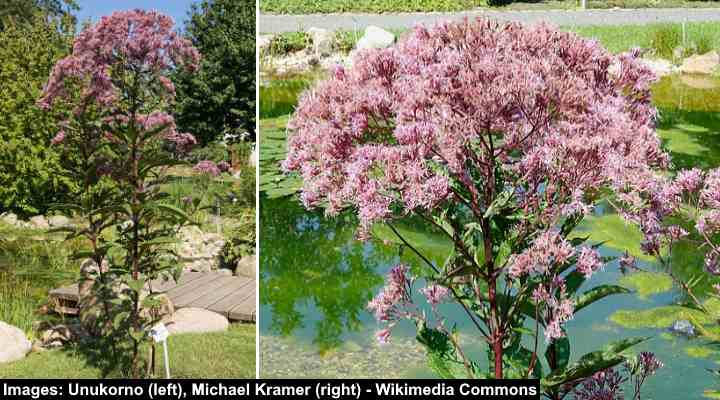
Joe-Pye weed flowers
Joe-Pye weed is a tall perennial plant known for its beautiful clusters of pinkish-purple flowers. This clump-forming plant has lanceolate green leaves, vanilla-scented light purple flowers, and attractive seed heads. The ornamental features of Joe Pye weed are appreciated when grouped to create impressive floral displays.
Joe Pye weed grows 5 to 7 ft. (1.5 – 2.1 m) tall. Its height, sturdy stems, and attractive foliage make it a good addition to the back of borders, native plant gardens, or naturalized areas. Also, its nectar-rich flowers attract butterflies and other pollinators.
- USDA Hardiness Zone: 4-9
- Light: Full sun to partial shade
- Soil: Moist, well-drained, humus-rich soils that don’t dry out
- Water Needs: Moderate to high
- Flowering Season: Late summer to fall
Bugleweed (Ajuga reptans)

Bugleweed flowers
Bugleweed is a mat-forming ground cover perennial plant that blooms with small blue-violet or purple flowers. The versatile perennial has clusters of flowers arranged on short spikes, evergreen dark green to purplish leaves, and a spreading habit. This hardy ground cover plant doesn’t grow taller than 8” (20 cm) and thrives in shaded areas.
Bugleweed is a great choice for gardens prone to deer and rabbit damage. Also, its ornamental attributes make it ideal for filling gaps in garden landscapes with flowers and foliage, edging pathways, suppressing weeds, and covering bare ground where other plants struggle. Also, the small rosettes of flowers attract butterflies, bees, and other pollinators.
It’s good to note that purple-flowering bugleweed is one of the few attractive perennials with excellent shade tolerance.
- USDA Hardiness Zone: 3-10
- Light: Full sun, partial shade, or deep shade
- Soil: Most soil types that are moist and well-draining
- Water Needs: Regular watering in full sun, less in shady conditions
- Flowering Season: Mid-spring to early summer
Chinese Meadow Rue (Thalictrum delavayi)

Chinese meadow rue (Thalictrum delavayi)
Chinese meadow rue is an eye-catching perennial with delicate purple-petaled flowers and creamy stamens. The lilac-mauve flowers dangle on purple stems, contrasting nicely with the feathery green foliage. Chinese meadow grows 3 to 5 ft. (1 – 1.5 m) tall, forming attractive clumps of green leaves and nodding purple flowers.
Chinese meadow rue flowers grow clustered together, creating a beautiful purple display. These flowers bloom in the summer for several weeks until fall. This easy-grow, cold-tolerant perennial attracts butterflies and other pollinators and is rabbit and deer-resistant. It’s an ideal purple-flowering plant for perennial borders, naturalized areas, and wildflower gardens.
- USDA Hardiness Zone: 4-7
- Light: Dappled sunlight to partial shade
- Soil: Moist, well-drained soils that have plenty of organic matter
- Water Needs: Average
- Flowering Season: Mid-summer through fall
Russian Sage (Perovskia atriplicifolia)
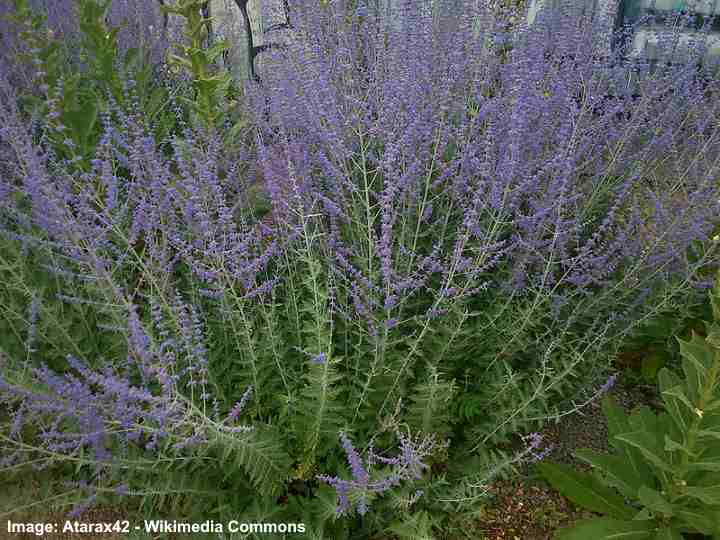
Russian Sage (Perovskia atriplicifolia)
Russian sage is a beautiful, long-blooming perennial plant with tall spikes of purple-bluish flowers. Growing up to 4 ft. (1.2 m) tall, this woody perennial has aromatic gray-green leaves and slender panicles of small purplish flowers. Its tolerance to drought makes it ideal for xeriscaping in drought-prone landscapes.
Russian sage has aromatic leaves, which emit a pleasant fragrance when brushed against. This hardy plant grows in attractive clumps and can be used as a small divider hedge, border edging, or desert flower. The purple plant requires little maintenance, with only minimal pruning required to keep it tidy.
- USDA Hardiness Zone: 4-9
- Light: Full sun
- Soil: Dry to medium well-drained soils
- Water Needs: Low as it is drought and salt-tolerant
- Flowering Season: Mid-summer through fall
Chinese Astilbe (Astilbe chinensis)
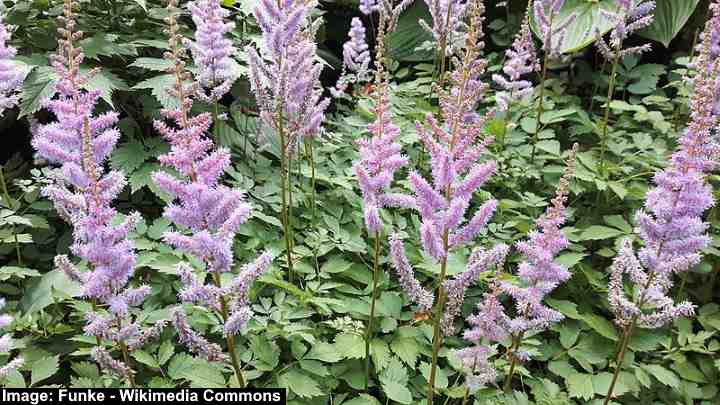
Chinese astilbe flower spikes
Chinese astilbe is a beautiful purple-flowering perennial with attractive feathery plumes blooming throughout summer. The conical flower clusters are hundreds of tiny purple flowers that bloom for a long time. Its ground cover foliage is mounds of fern-like green leaves. Chinese astilbe thrives in the shade—an ideal perennial for shady borders or underplanting shrubs.
Chinese astilbe grows 3 to 4 ft. (1 – 1.2 m) tall. Grow the purple perennial in partial shade for best results, ensuring the soil is consistently moist. Mulching around the roots can also prevent evaporation. You must water the plant regularly in hot summers to keep it flowering throughout the summer.
Chinese astilbe is ideal for planting in borders, woodland gardens, or along streams and ponds. Its stunning display of purple blooms also makes beautiful fresh-cut flowers or to decorate dried flower arrangements.
- USDA Hardiness Zone: 4-9
- Light: Dappled sunlight, partial shade, or full shade
- Soil: Evenly moist, well-drained soils rich in organic matter
- Water Needs: Regular, above average requirements
- Flowering Season: Mid to late summer
Bigleaf Periwinkle (Vinca major)
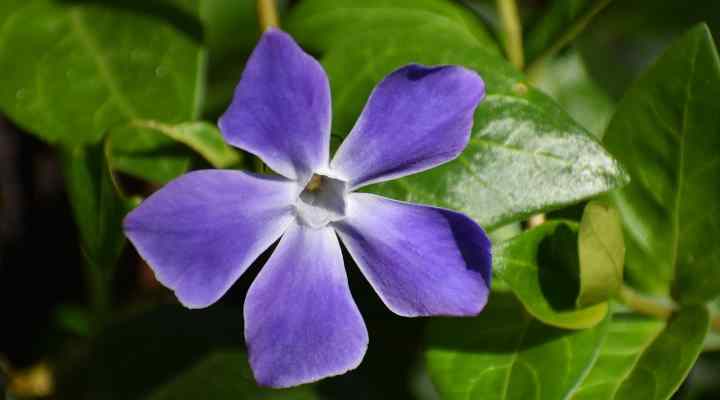
A close up picture of bigleaf periwinkle flower
Bigleaf periwinkle is an evergreen perennial ground cover plant that blooms with beautiful five-petalled blue-violet flowers. The mat-forming plant thrives in the shade and blooms from spring through fall. Its carpet of dense evergreen foliage is glossy, ovate leaves that grow on prostrate stems. The purple perennial grows up to 18” (45 cm) tall and spreads indefinitely.
Bigleaf periwinkle flowers are a vibrant shade of purple with contrasting white throats. It’s one of the few purple-flowering ground cover plants that tolerate deep shade. Its tolerance for drought, dry soil, and full sun makes it highly versatile in most landscapes.
Periwinkle is also deer-resistant, making it a great choice for gardens in areas with deer populations.
- USDA Hardiness Zone: 7-9
- Light: Full sun, partial shade, or full shade
- Soil: Well-drained medium moisture soils, but drought-tolerant once established
- Water Needs: Low to moderate
- Flowering Season: Early spring to late fall
Columbine (Aquilegia vulgaris)
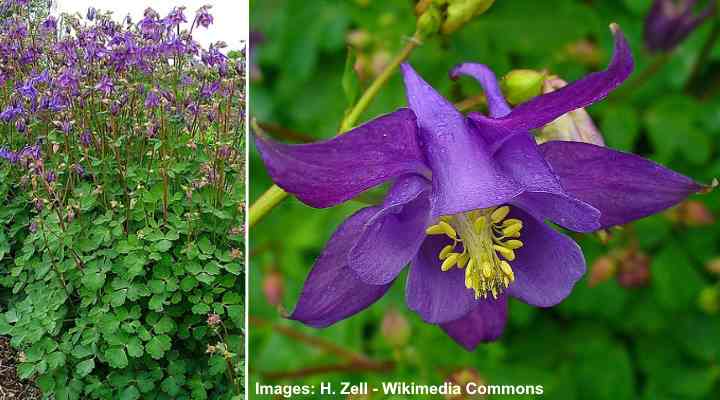
Columbine (Aquilegia vulgaris)
Columbine is a beautiful, short-lived perennial plant that comes in various colors, including shades of purple. The clump-forming plant has delicate, bell-shaped nodding flowers on thin, leafy stems. Columbine flowers bloom in late spring and early summer. The plant has gray-green, fern-like lobed leaves.
Purple-flowering perennial columbine grows 1 to 3 ft. (0.3 – 1 m) tall. It naturalizes easily in gardens thanks to its self-seeding habit. The attractive purple flowers look beautiful in rock gardens, shade gardens, and mixed beds. Also, the flowers attract butterflies and hummingbirds and are resistant to deer and rabbits.
- USDA Hardiness Zone: 3-8
- Light: Partial shade to full sun
- Soil: Rich, moist, well-drained soils
- Water Needs: Average requirements to keep the soil from drying out
- Flowering Season: Late spring to early summer
Lungwort (Pulmonaria saccharata)
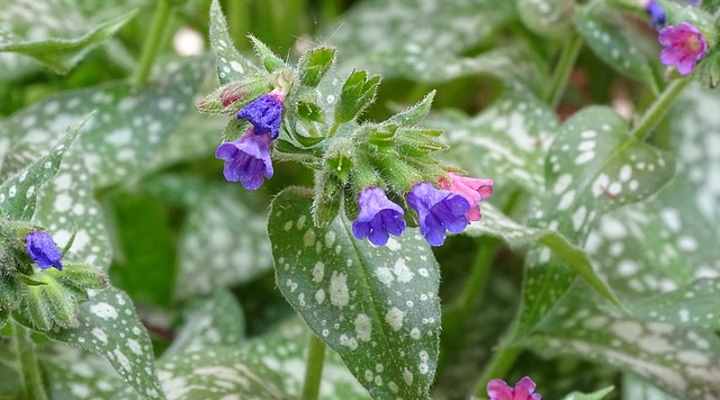
Lungwort (Pulmonaria saccharata)
Lungwort is a colorful perennial plant for partial shade or full shade gardens that produces clusters of purple and pink flowers. This plant has attractive foliage with spotted or mottled silver or white patterns. Lungwort tubular flowers bloom in early spring and last for several weeks. The semi-evergreen, clump-forming plant grows 1 ft. (0.3 m) tall.
Lungwort is a shade-tolerant perennial that stays evergreen in mild winter regions. As long as the soil is moist, it blooms for several weeks, creating color and texture in shaded beds, borders, and under shrubs or trees. It’s also a versatile ground cover plant with purple flowers for deep shade.
- USDA Hardiness Zone: 3-9
- Light: Partial shade to heavy shade
- Soil: Moist, well-drained, organically rich soils
- Water Needs: Regular to prevent the soil from drying out
- Flowering Season: Early spring to early summer
Monkshood (Aconitum carmichaelii)
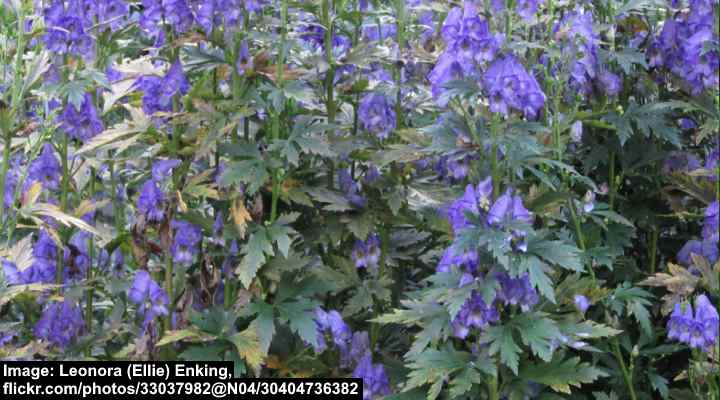
Aconitum carmichaelii ‘Arendsii’
The attractive quality of perennial monkshood is its dense spires of rich, deep purple tubular flowers. The hooded flowers grow on rigid stems surrounded by deeply divided, dark green, leathery leaves. The stunning purple flowering perennial grows 2 to 4 ft. (0.6 – 1.2 m) tall and 1.5 ft. (0.45 m) wide.
Monkshood blooms in summer and reblooms in fall. The rich purple, azure-blue, and deep blue colors add vibrancy to garden landscapes when many other plants have finished flowering. Also, its flowers attract hummingbirds and pollinators, and its foliage is deer and rabbit-resistant.
It’s important to note that monkshood is highly toxic, so it should be handled carefully. It’s best to wear gloves when working with this plant and keep it away from children and pets.
- USDA Hardiness Zone: 3-8
- Light: Full sun to partial shade
- Soil: Organically rich, moist, well-drained soils
- Water Needs: Moderate watering to ensure the ground doesn’t become dry
- Flowering Season: Summer and fall
Nepeta Catmint (Nepeta x faassenii)
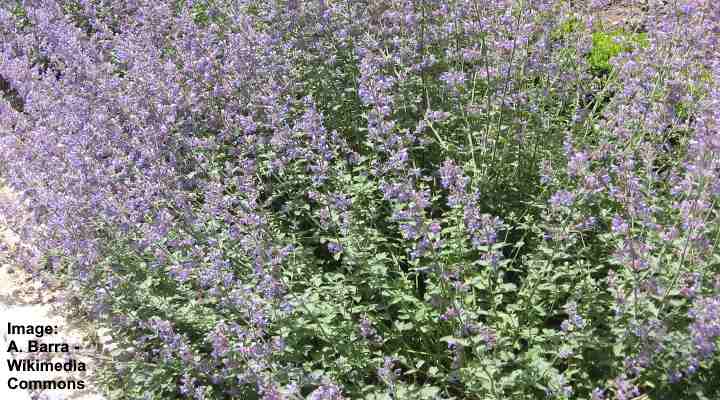
Nepeta catmint flowers
Also called cat’s meow, nepeta catmint is an herbaceous perennial with attractive spikes of purple flowers. This low-growing plant forms mounds of gray-green foliage and produces clusters of small lavender-blue flowers. The flowers bloom from late spring to early summer and attract bees, butterflies, and other pollinators to the garden.
Nepeta catmint is a hardy perennial that grows up to 2 ft. (0.6 m) tall and 3 ft. (1 m) wide. Its tolerance to dry soils makes it a great choice for arid landscapes. Its beautiful flowers add color to perennial borders, wildlife gardens, path edging, and underplanting of large shrubs.
In addition to its beautiful flowers, Nepeta catmint also has a pleasant fragrance. The leaves of the plant release a minty scent when crushed, making it a great addition to herb gardens or as a border plant. Deer and rabbits ignore the leaves and flowers.
- USDA Hardiness Zone: 3-8
- Light: Full sun
- Soil: Dry to medium well-drained soils
- Water Needs: Low to moderate
- Flowering Season: Early summer to late fall
Common Foxglove (Digitalis purpurea)
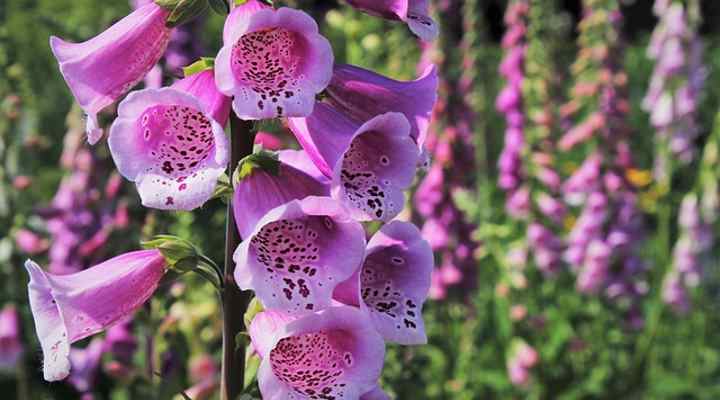
Common Foxglove (Digitalis purpurea)
Common foxglove is a tall perennial plant that produces stunning tubular purple flowers on long spikes. The attractive rosy-purple flowers have distinctive spotted patterns inside. The flowers measure 2” to 3” (5 – 7.5 cm) long and bloom throughout summer. Foxglove flowering spikes can grow up to 5 ft. (1.5 m) tall.
Common foxglove—also called bloody bells, lady’s glove, or fairy thimbles—is ideal for planting along a fence line. The tall, vibrantly colored flowers create a visual impact at the back of borders, cottage gardens, or coastal landscapes. The attractive tubular flowers attract hummingbirds, and birds flock to consume the seeds in the fall.
- USDA Hardiness Zone: 4-8
- Light: Full sun to partial shade
- Soil: Moist, well-drained, humus-rich soils
- Water Needs: Regular watering to keep the soil moist without becoming soggy
- Flowering Season: Late spring to mid-summer
Purple de Oro Daylily (Hemerocallis ‘Purple de Oro’)
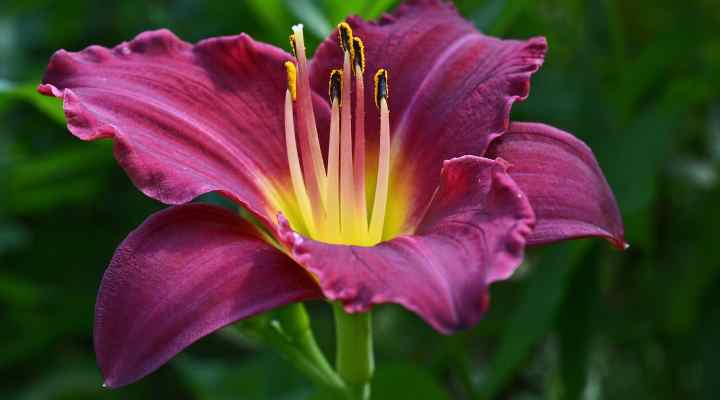
Purple de Oro Daylily (Hemerocallis ‘Purple de Oro’)
‘Purple de Oro’ daylily is a vigorous purple perennial producing showy plum-purple blooms throughout summer. The stunning funnel-shaped flowers have large, ruffled petals in rosy-purple shades with golden throats. These contrast with blade-like arching leaves growing in clumps at the stem bases.
‘Purple de Oro’ daylilies grow 1 to 2 ft. (0.3 – 0.6 m) tall. Their showy flowers measure 3” (7.5 cm) wide. The compact perennials bloom from early summer to early fall, adding a touch of vibrancy to gardens. The drought and heat-tolerant flowers look spectacular in perennial beds, shrub borders, or growing in planters.
This daylily is also drought-tolerant and rabbit-resistant but attracts hummingbirds and butterflies, making it a great choice for sunny wildlife gardens. It also thrives in most hardiness zones in the United States—a reason why it’s called the perfect perennial.
- USDA Hardiness Zone: 3-9
- Light: Full sun to partial shade
- Soil: Well-drained, loamy soils
- Water Needs: Average watering to keep the soil moist
- Flowering Season: Early summer to early fall
Sea Holly ‘Tiny Jackpot’ (Eryngium planum ‘Tiny Jackpot’)
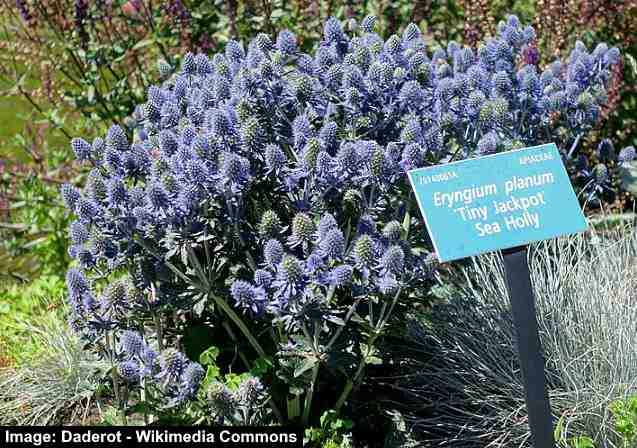
Sea Holly ‘Tiny Jackpot’ (Eryngium planum ‘Tiny Jackpot’)
Sea holly ‘Tiny Jackpot’ is an eye-catching compact perennial plant with steely-blue or pale purple thistle-like flowers. The low-growing perennial is identified by its spiky egg-shaped purple flowers surrounded by spiny silver-blue bracts, creating a striking contrast. The plant has a basal rosette growing 6” (15 cm) tall and 14” (35 cm) wide.
Sea holly flowers bloom in summer, attracting butterflies and bees to your garden. The compact, spiky plant is ideal for landscaping small gardens in full sun where water is limited. This purple perennial plant is also rabbit and deer-resistant, making it a great choice for rural gardens with wildlife problems.
- USDA Hardiness Zone: 4-8
- Light: Full sun
- Soil: Well-drained, dry, sandy soil and highly drought tolerant
- Water Needs: Low to moderate
- Flowering Season: Throughout summer
Culver’s Root (Veronicastrum virginicum)
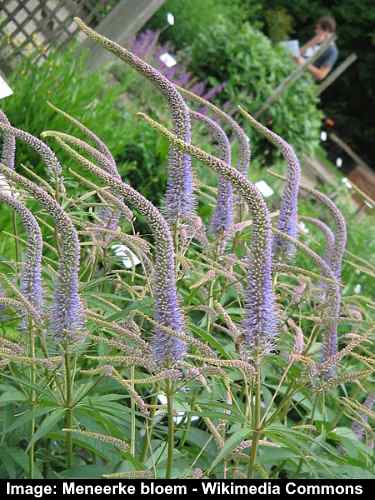
Culver’s Root (Veronicastrum virginicum)
Culver’s root is a tall perennial plant with stunning purple flower spires that bloom from mid-summer to fall. The eye-catching ornamental features of the plant are cylindrical candelabra-like flower clusters and dark green, lanceolate leaves growing in whorls around the stems. Culver’s root grows 5 to 6 ft. (1.5 – 1.8 m) tall and 2 ft. (0.6 m) wide.
Culver’s root is a hardy perennial that tolerates various soil conditions. It performs well as an accent plant or in perennial borders, mixed shrub plantings, or wildflower gardens. The pale lavender flowers attract bees, butterflies, and other pollinators to gardens.
Additionally, the plant is deer-resistant and has few disease or pest issues, making it a low-maintenance landscaping solution where deer and wildlife are a problem.
- USDA Hardiness Zone: 3-8
- Light: Full sun or light shade
- Soil: Moist, well-drained soils that stay consistently moist
- Water Needs: Average to prevent the soil from drying out
- Flowering Season: Mid-summer to early fall
Creeping Mazus (Mazus reptans)
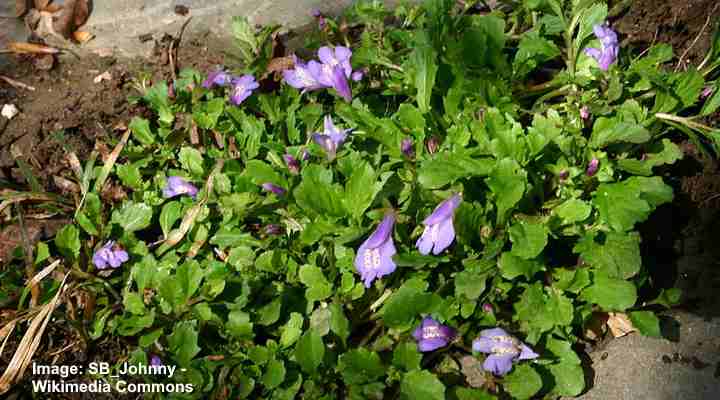
Creeping Mazus (Mazus reptans)
Creeping mazus is a low-growing perennial plant with purple flowers that create a carpet of dense foliage. The ornamental attributes of the plant are its small, tubular, purple flowers with white and yellow markings and bright green, narrow leaves. The spreading perennial covers the ground, quickly spreading through rooting stems.
Creeping mazus flowers are delicate and vibrant, adding a splash of pastel colors to gardens. Due to its low growth habit, it’s an ideal plant for ground cover, filling in gaps between stepping stones, rock gardens, or underplanting shrubs. The vigorous purple perennial prefers moist, well-drained soil and partial shade.
- USDA Hardiness Zone: 5-8
- Light: Partial shade but tolerates full sun
- Soil: Well-drained soils that are consistently moist
- Water Needs: Average watering requirement to keep the ground damp in summer
- Flowering Season: Late spring to summer
Hoary Vervain (Verbena stricta)

Hoary Vervain (Verbena stricta)
Hoary vervain is a beautiful perennial, clump-forming plant that produces clusters of small purple or lavender flowers. Native to North America, the perennial has a long blooming season in summer, with its tiny star-shaped flowers growing in cylindrical spikes. These flowering stems can grow 2 to 4 ft. (0.6 to 1.2 m) tall.
Hoary vervain flowers bloom for six weeks from mid-summer. The showy panicles attract butterflies and bees, enhancing your garden’s biodiversity. Its leaves are gray-silver, 4” (10 cm) long, and grow at the base of the flower stems.
Vervain is a hardy perennial that can withstand a wide range of temperatures. Its tolerance for salt spray, drought, and full sun makes it a great addition to gardens throughout North America. To add vibrant purple colors and lush textures, you can plant it in butterfly gardens, woodland landscapes, and coastal areas.
- USDA Hardiness Zone: 4-8
- Light: Full sun
- Soil: Well-drained, dry, sandy, rocky, or clay soils
- Water Needs: Moderate
- Flowering Season: Mid-summer and throughout fall
Blue Mistflower (Conoclinium coelestinum)
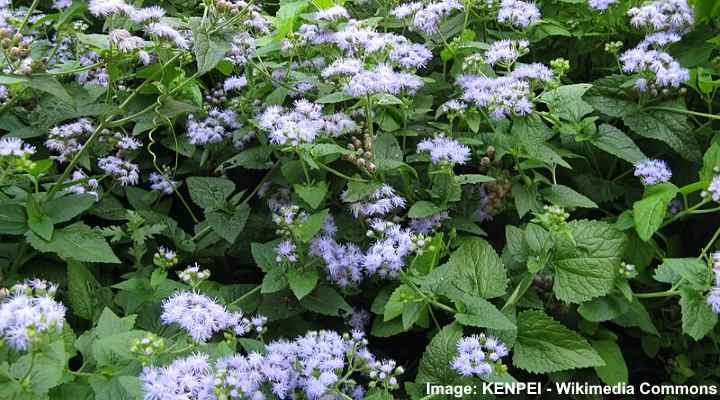
Blue Mistflower (Conoclinium coelestinum)
Blue mistflower has flattened clusters of fluffy violet flowers that bloom in mid-summer for a long time. This purple perennial has green, triangular leaves creating dense foliage. Its clusters of purple flowers grow atop purplish stems, attracting large numbers of butterflies and bees in summer. It grows 1 to 3 ft. (0.3 – 1 m) tall.
Blue mistflower grows well as fast-growing ground cover in sunny or partially shaded landscapes. Its long-blooming season means it continues adding color to landscapes when other flowers fade. However, it has invasive tendencies if left uncontrolled.
- USDA Hardiness Zone: 5-10
- Light: Full sun to partial shade
- Soil: Moist, well-drained, humus-rich, fertile soils
- Water Needs: Moderate to keep the ground moist
- Flowering Season: Late summer to early fall
Pasque Flower (Pulsatilla vulgaris)

The Pasque flower is a stunning, beautiful perennial with star-shaped, showy purple flowers and vibrant yellow centers. The ornamental spring-blooming bell-shaped flowers have fuzzy petals with irregular margins, feathery foliage, and plume-like seed heads. The perennials emerge in early spring and produce flowers for several months.
Not growing over 1 ft. (0.3 m) tall, this low-growing plant is native to Europe and can be found in meadows and rocky areas. Thriving in full sun, the low-maintenance hardy perennial is a great addition to rock gardens, border fronts, and wildflower gardens. They also make excellent cut flowers, adding a touch of purple to floral arrangements.
- USDA Hardiness Zone: 4-8
- Light: Full sun
- Soil: Well-drained, fertile, humus-rich soils
- Water Needs: Moderate
- Flowering Season: Throughout spring
Coralbells (Heuchera)

Heuchera ‘Forever Purple’ and ‘Palace Purple’ are perennial plants with plum colored leaves
If you are looking for a purple-leaf perennial, some Coralbell (Heuchera) cultivars are a good choice. For example, types such as ‘Plum Pudding,’ ‘Purple Palace,’ ‘Purple Petticoats’ and ‘Dark Secret’ can add stunning dark foliage to your garden landscape.
Cora bells grow best in full sun to partial shade, and they like a neutral to slightly acidic soil with good drainage. Being relatively low perennial plants, plant them in groups for beautiful purple ground cover effect or at the front of beds and borders.
- USDA Hardiness Zone: 4 to 9
- Light: Full sun to partial shade
- Soil: Neutral to slightly acidic soil with good drainage
- Water Needs: Moderate watering needs
- Flowering Season: Spring to summer
Purple Heart Tradescantia (Tradescantia pallida)
Famed for its purple foliage and pale purple flowers, the Purple Heart (Tradescantia pallida) is a great addition to add striking color to a garden.
This flowering purple perennial is a low-growing trailing plant that is good as a bedding plant at the front of flower beds and borders, or in a hanging basket. Although the Purple Heart blossoms during the summer, its light-purple petals are not too pronounced. Usually, most gardeners plant this type of Tradescantia to contrast the plum-colored leaves with other green plants.
To grow this common purple flowering plant outdoors, you need to be in a temperate climate as it is a tender perennial. You can also plant it in containers as a flowering indoor plant where its trailing purple stems will add a nice feature to your room.
Purple Heart Tradescantia grows best in partial shade. Indirect sunlight helps to bring out its purple color, but protect from direct afternoon sun or strong summer sunlight.
- USDA Hardiness Zone: 10-11
- Light: Partial shade
- Soil: Well-drained
- Water Needs: Moderate
- Flowering Season: Summer
Purple Emperor Stonecrop (Sedum telephium ‘Purple Emperor’)
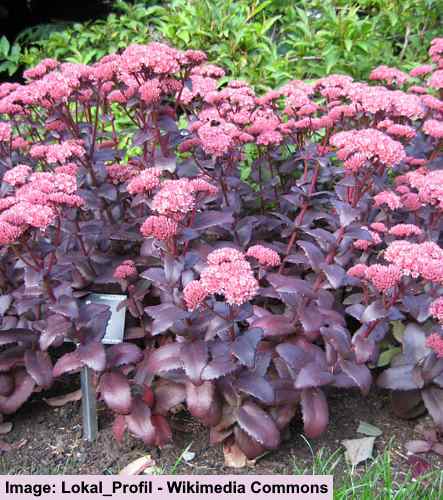
Stonecrop ‘Purple Emperor’ (Sedum telephium ‘Purple Emperor’)
‘Purple Emperor’ stonecrop is a stunning purple-leaf perennial that adds vibrancy and rich colors to front or backyards. The plant’s outstanding features are its umbrella-like clusters of star-shaped, rosy-pink flowers, dark purple, succulent leaves, and reddish-purple stems. The easy-to-grow perennial keeps its visual interest for at least six months of the year.
The stonecrop ‘Purple Emperor’ cultivar grows 1 to 2 ft. (0.3 – 0.6 m) tall and wide. In a garden landscape, the purple perennial plant is ideal for growing in borders or planted en masse for visual effect. Its nectar-rich flowers attract bees, butterflies, and other beneficial insects.
- USDA Hardiness Zone: 3-9
- Light: Full sun
- Soil: Average, dry to medium, well-drained moisture soils
- Water Needs: Low to moderate
- Flowering Season: Mid-summer through to early winter
Related articles:
- Types of Flowers: Different Kinds Of Flowers With Name and Picture
- 18 Ground Cover Plants for Shade (Including Pictures)
- 17 Ground Cover Plants for Full Sun, Including Pictures


